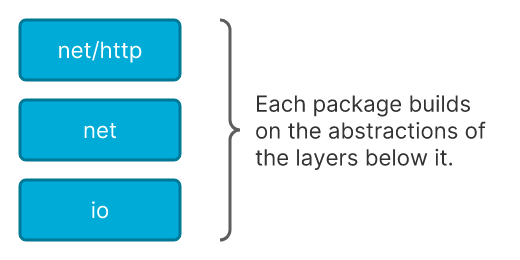「译」以层的方式而不是组的方式进行包管理
原文地址:https:/www.gobeyond.dev/packages-as-layers/
原文作者:Ben Johnson
本文永久链接:https:/github.com/gocn/translator/blob/master/2021/w7_packages_as_layers_not_groups.md
译者:cvley
校对:guzzsek
四年之前,我写了一篇包管理标准 的文章,试图解决即使是高级Go开发者也觉得困难的话题之一:包管理。然而,大多数的开发者依旧挣扎于使用文件夹结构的代码组织方式,而在这种方式下,随着应用的发展,目录结构也会慢慢增长而日趋复杂。
几乎所有的编程语言都有一个将功能集合的机制。Ruby有gems,Java有包管理。而那些没有组织代码标准约定的语言,老实说,是不关心代码组织的方式。所以这就完全依赖个人选择了。
然而,转换到Go语言的开发者会经常发现,他们的包管理方式常常会反噬。为何Go的包与其他语言如此不同?这是因为不是组的关系——而是层的关系。
理解循环依赖
Go的包和其他语言组合方式的一个主要区别是Go不支持循环依赖。A包可以依赖B包,那么之后B包就无法再依赖A包。

包的依赖关系只是单向的。
对于开发者来说,当他们在两个包中共享通用的代码时,这个限制就会导致问题。一般来说有两个解决方法:要么将两个包合二为一,要么引入第三个包。

但是,不断分裂更多的包只能掩盖问题。最后,只剩大量的包而没有真实的结构。
借鉴标准库
在Go编程需要指导时,最有效的方法之一是阅读标准库。没有完美的代码,但Go的标准库中封装了大量这门语言创造者们的理想代码。
比如,net/http包构建在net包的抽象基础之上,而net包则是构建在下面io层的抽象之上。想象一下net包在某种情况下依赖net/http包是多么的荒谬,你就会发现这种包结构非常合理。

虽然这种方式在标准库中有效,但很难在应用开发中使用。
在应用开发中使用层的方式
接下来我们看下一个叫做WTF Dial的示例应用,你可以阅读介绍文章进一步了解详情。
在这个应用中,我们有两个逻辑层:
一个SQLite数据库 一个HTTP服务
我们分别为这两个逻辑创建包——sqlite & http。很多人在对包的命名与标准库的包一样时会有些犹豫。这个想法是对的,你可以把它命名为wtfhttp,但是我们的HTTP包将完全封装net/http,而且我们不会在同个文件中同时使用这两个包。我觉得在每个包名字前都加前缀的做法很无聊也很丑,所以我不会这么干。
直接的方法
设置应用结构的一个方法是把数据类型(如User、Dial)和函数(如FindUser()、 CreateDial())放在sqlite中。http包将直接依赖于它:

这个方法不错,对于简单的应用也有效。但最后我们还是会遇到一些问题。首先,我们的数据类型命名是sqlite.User和sqlite.Dial。这听起来有些奇怪,因为数据类型应该属于应用——而不是SQLite。
其次,HTTP层现在就只能托管SQLite的数据。如果我们想在中间增加缓存层怎么办?或者我们如何支持其他类型的数据存储方式,比如Postgres或直接在磁盘上存储的JSON文件?
最后,因为没有抽象层来模拟SQLite数据库,在每次HTTP测试时我们将不得不运行SQLite服务。一般来说,我支持尽可能多地进行端到端的测试,但在更高层引入单元测试的做法也有适用的场景。尤其是在引入云服务的场景下,你肯定不想每次测试调用时都运行云服务。
隔离业务领域
修改的第一步是将_业务领域_移动到单独的包内。这也叫做“应用领域”。它表示的是应用特定的数据类型——比如在WTF Dial中的User, Dial。
在这个例子中我使用根包(wtf),因为它和应用名字一样,而且是新开发者打开代码仓库时最先看到的地方。类型的命名使用更加合适的wtf.User和wtf.Dial。

可以看下wtf.Dial类型的例子:
type Dial struct {
ID int `json:"id"`
/ Owner of the dial. Only the owner may delete the dial.
UserID int `json:"userID"`
User *User `json:"user"`
/ Human-readable name of the dial.
Name string `json:"name"`
/ Code used to share the dial with other users.
/ It allows the creation of a shareable link without
/ explicitly inviting users.
InviteCode string `json:"inviteCode,omitempty"`
/ Aggregate WTF level for the dial.
Value int `json:"value"`
/ Timestamps for dial creation & last update.
CreatedAt time.Time `json:"createdAt"`
UpdatedAt time.Time `json:"updatedAt"`
/ List of associated members and their contributing WTF level.
/ This is only set when returning a single dial.
Memberships []*DialMembership `json:"memberships,omitempty"`
}
dial.go#L14-50
在上面的代码中,没有任何实现细节的引用——只有基础类型和time.Time。为了方便,也添加来JSON标签。
通过抽象服务移除依赖
我们的应用结构看起来好了一些,但HTTP依赖SQLite这点依旧有些奇怪。HTTP服务器会从一个潜在的数据库里获取数据——不会特别关心它是SQLite还是别的。
要修复这个问题,我们可以在业务领域创建服务的接口。这些服务是典型的创建、读取、更新、删除(CRUD)操作,但可以扩展到其他的操作。
/ DialService represents a service for managing dials.
type DialService interface {
/ Retrieves a single dial by ID along with associated memberships. Only
/ the dial owner & members can see a dial. Returns ENOTFOUND if dial does
/ not exist or user does not have permission to view it.
FindDialByID(ctx context.Context, id int) (*Dial, error)
/ Retrieves a list of dials based on a filter. Only returns dials that
/ the user owns or is a member of. Also returns a count of total matching
/ dials which may different from the number of returned dials if the
/ "Limit" field is set.
FindDials(ctx context.Context, filter DialFilter) ([]*Dial, int, error)
/ Creates a new dial and assigns the current user as the owner.
/ The owner will automatically be added as a member of the new dial.
CreateDial(ctx context.Context, dial *Dial) error
/ Updates an existing dial by ID. Only the dial owner can update a dial.
/ Returns the new dial state even if there was an error during update.
/
/ Returns ENOTFOUND if dial does not exist. Returns EUNAUTHORIZED if user
/ is not the dial owner.
UpdateDial(ctx context.Context, id int, upd DialUpdate) (*Dial, error)
/ Permanently removes a dial by ID. Only the dial owner may delete a dial.
/ Returns ENOTFOUND if dial does not exist. Returns EUNAUTHORIZED if user
/ is not the dial owner.
DeleteDial(ctx context.Context, id int) error
}
dial.go#L81-L122
现在我们的领域包(wtf)不仅设置了数据结构,也设置了层间交互的接口约定。这让包结构变得扁平,这样所有的包都可以依赖这个领域包。这让我们打破包间的直接依赖,并可以引入另一种实现比如mock包。

重新封包
将包间依赖打破,增加了我们使用代码的灵活性。对于应用的二进制文件,wtfd,我们依旧想让http依赖sqlite( 参见[wtf/main.go](https:/github.com/benbjohnson/wtf/blob/main/cmd/wtfd/main.go#L180-L205)),但对于测试我们可以让http依赖新的mock包(参见[http/server_test.go](https:/github.com/benbjohnson/wtf/blob/main/http/server_test.go#L22-L59)):

在这个小web应用WTF Dial上这么使用有些杀鸡用牛刀,但随着代码仓库的不断增加,这么处理会越来越重要。
结论
在Go语言中,包是一个强有力的工具,但如果你把它们按组而不是按层来管理,就会陷入无穷的沮丧中。在理解来应用的逻辑层后,应用领域的数据类型和接口约定可以抽取出来,放到根包中作为一个对所有子包都通用的领域语言。对于不断发展的应用有必要定义这种领域语言。
有问题或者评论?欢迎在WTF Dial GitHub 讨论版留言。
